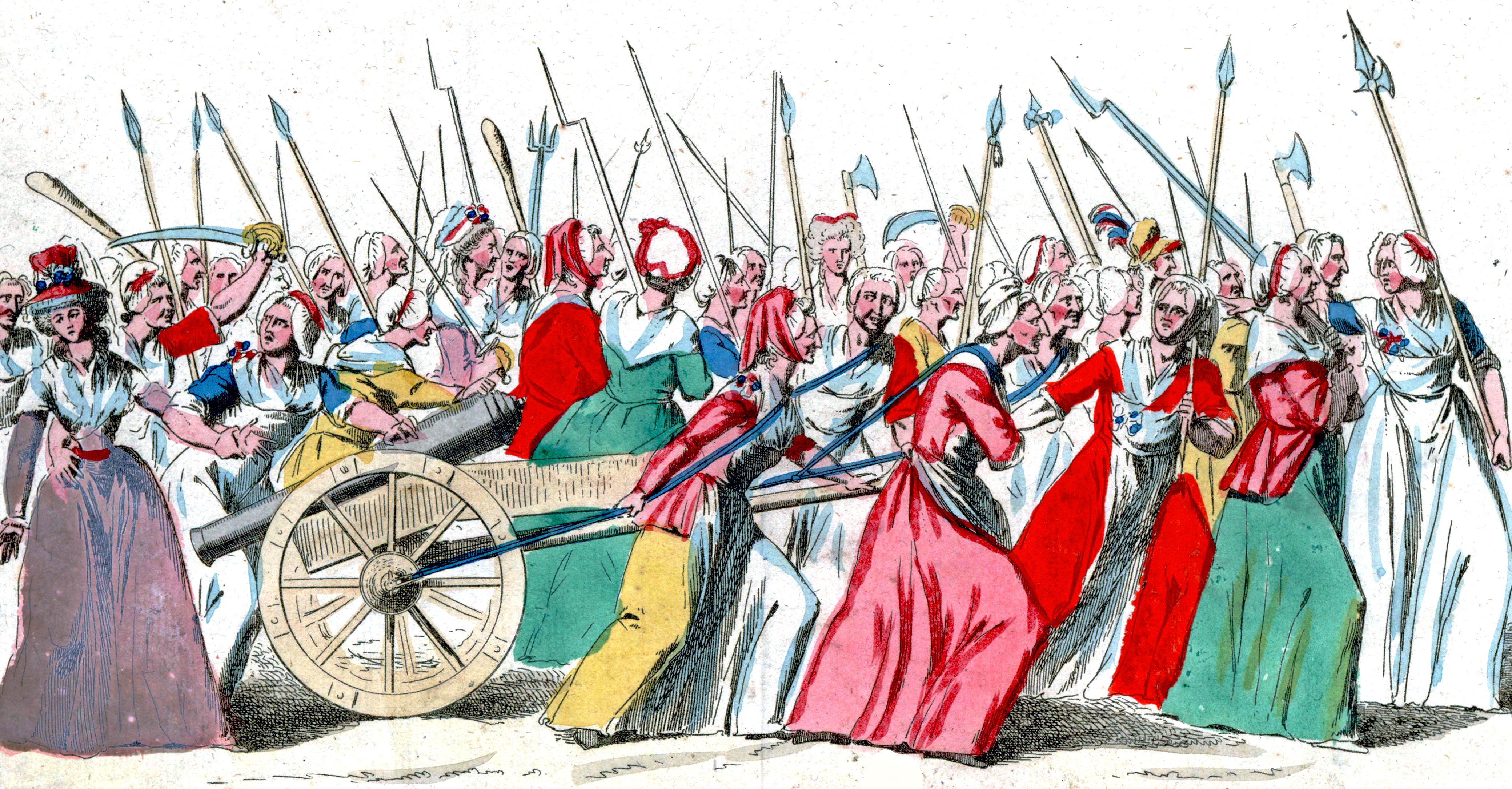By: Elizabeth Larkin Bouché
As inauguration day approaches and women ready themselves for the Women’s March on Washington, I am reminded of Europe’s most remarkable uprising of women against tyranny—The Women’s March on Versailles in 1789.
It was a major, dramatic event on a par with the storming of the Bastille. A food riot in Paris, led seven thousand women, transformed into an armed march to take flour from the king’s stores 12 miles away in Versailles. Revolutionaries seized the opportunity to join the women and forced the king to sign the recently composed “Declaration of the Rights of Man,” so ending his absolute rule. The king and his entourage were dragged back to the capital as prisoners. It was a turning point in history, signaling a shift in power from the nobility to the common people.
The Women’s March on Versailles is a reminder of the power of popular protest movements. Following the election of Trump, and spurred by growing unease with our own Versailles-like oligarchs, similar protests are now cropping up at grassroots level in the United States. The Paris women were driven by famine; they and their children were hungry. Women today are mobilized by threats to hard-won advances made since the Enlightenment. The ordinary women who have organized the March on Washington are unleashing what is perhaps a primal and formidable maternal fury once again.
The comparison between revolutionary France and current events is not so far-fetched. Civil unrest in Paris was fueled by paranoid plots in the press and fake news. It was also the result of basic needs becoming unaffordable, market deregulation, widespread distrust of government, huge national debt, and deeply divided political opinions. One key factor was the staggering inequality of the ancien régime, in which the clergy and nobles, or first and second estates, held vast wealth and paid no taxes, while the third estate, or 97 percent of the population, were heavily taxed for foreign wars. The parallels did not escape the notice of “Time” magazine. Its person of the year cover featured Trump seated on a tawdry carved chair decorated with a fleur-de-lis, the symbol of the French monarchy. Indeed, Trump draws the comparison himself when he chooses to be interviewed while seated in a gilded throne in his French Rococo-style dwellings.
Considering all this, and with large numbers of women taking to the streets, it is interesting to look at what drove French women to insurrection at a powder keg moment in history.
In 1789, after two years of bad harvests, the poor lived in dread of hunger, leading to street riots over the shortage of bread costing an average 50 percent of wages. A new popular press announced conspiracies, raised fears, and exhorted action: “Open your eyes, shake yourselves out of your torpor. Wake up, wake up.” Propaganda accused nobles of starving them deliberately. Popular blame lashed against the foreign queen, Marie-Antoinette, known as l’Autri-chienne, a French play on words referring to her as Austrian and a bitch, who was hated for lavish spending during times of public austerity. As in our recent election, fake news played on xenophobic and misogynist instincts of the populace with vicious attacks on the queen. The famous story that she said, “Let them eat cake,” on hearing of bread shortages is actually a post-Revolutionary myth, but it reflects the mood of the day.[1]
The ancien régime had led France to the brink of bankruptcy by financing America’s War of Independence, leaving the poor to pay through heavy taxation. Ensconced for over a century in the luxury of Versailles Palace, 12 miles from Paris, the nobility had long been isolated from the teeming city mobs, their poverty and demands. These demands took shape when the new Assembly wrote the “Declaration of the Rights of Man,” and pressed for the king and his court to reside in Paris, close to their subjects and their elected representatives in the capital.
Common citizens discovered a new desire to participate in politics. Activists prepared to seize power from the privileged orders of the nobility and establish a constitutional monarchy. Citizens attacked the Bastille Prison, plundering its arms and gunpowder, and taking down this symbol of despotism stone by stone. Women were involved in these upheavals as never before, joining revolutionary crowds, and publishing journals, political tracts, and plays with a full range of diverse opinions. Yet there arrived a momentous time when it was illiterate women who led the spectacular charge on the king’s authority.
On October 5, 1789, against a backdrop of famine and rage, a crowd of market women gathered near the city hall to protest bread shortages. A young woman beat a marching drum on the edge of the crowd and the mob forced a nearby church to toll its bells. Women arrived from marketplaces all over the city, swelling the crowd to six-thousand, or as many as ten-thousand strong. News that the king was sending royal troops against them infuriated the market women, among them the fearsome fishmongers, les poissardes, muscular from carting boxes and wielding fish knives, and others brandishing pikes and scythes. The mob raided the city hall for stores of flour and weapons, including several cannons. While the women’s chief aim was to secure ample food supplies from royal stores, activists who sought a march to the king for political aims shouted, “A Versailles!”
They marched six hours through the autumn rain, gathering followers, boisterously boasting of their intention to bring back the king and calling for the death of Marie-Antoinette. Arriving at the Palace of Versailles, they set up a great encampment of exhausted but determined women, and laid siege to the royal court. They sent a delegation of six women along with the President of the Assembly to the king’s apartment with their demands. Louis promised a provision of food from his stores with more to come, but he hesitated to accept an immediate move to Paris.
That was to prove a nearly fatal mistake. The women remained unpacified by his handouts of royal flour, and circulated rumors that he had no intention of offering more. To quell the mounting tide of insurgency, the king agreed to sign the “Declaration of the Rights of Man.” But by this time, the Marquis de Lafayette, facing a mutiny of the National Guard, had arrived with thousands of troops who demanded to back up the army of women. Their arrival restored the women’s vigor as they huddled and mingled all night by bonfires at the palace gate, some clamoring for blood.
At daybreak, a wave of them broke through a gate, violence boiling over into savagery. The women massacred and decapitated guards, impaling their heads on pikes. They ran through the palace, demanding the queen’s entrails, an arm or leg. If the queen hadn’t fled barefoot to the king’s chambers, she might have been torn apart. Instead the attackers shredded her mattress. Their allied guardsmen followed them in to the palace with their guns. By afternoon, the king was forced to submit to returning to Paris, his cortege led by the heads of his palace guards on pikes, and flanked by wagons full of flour for the triumphant marchers, shouting they had brought back “The baker and the baker’s wife!” The vast throng had grown to 60 thousand people, with guardsmen waving loaves of bread on bayonets and market women astride the captured cannons. From then on, the royal family was under house arrest until their eventual execution. The women were hailed by the Assembly and by a succession of later governments as “Mothers of the Nation.”
It astonished the world that illiterate women could bring home those wagonfuls of food to feed their children, which was their main aim, while at the same time striking a major blow against the monarchy. Indeed, it is still an astonishing victory.
As an American expat, I’ll be marching the day after Trump’s inauguration at the Paris march, in the path of those 18th century women who dealt one of the first blows against the seemingly invincible nobility. Our march will be an echo of theirs, recalling the deep connection between French and American democracy. The “Declaration of the Rights of Man” that the women of Paris forced their king to sign was based on the American “Declaration of Independence.” Thus in a sense, the Women’s March on Versailles was a Franco-American action and its success is a shared democratic legacy of the two nations.
I hope the Women’s March on Washington will be the beginning of a sustained movement. We should not lose ground on the women’s rights that we have fought for over centuries. We should not allow ourselves to be ruled by the unaccountable oligarchy which is our new ancien régime, for they do not rule in our interests. We must start more actions towards shared prosperity. We should be vigilant on issues of sexual assault and discrimination, racism, sectarianism, xenophobia, civil liberties, freedom of speech, truth and transparency, justice, international law, comity, and our Constitution. Women have awakened to the need to leave a legacy that is intact or improved, to assure our children’s future, as women before us fought for their children. As the Women’s March on Washington states on its Facebook page, “We will send a bold message to our new administration on their first day in office, and to the world, that women’s rights are human rights. We stand together, recognizing that defending the most marginalized among us is defending all of us.”
[1] According to historian Lady Anatonia Fraser and biographer of Marie-Antoinette the phrase, “was said 100 years before her by Marie-Thérèse, the wife of Louis XIV. It was a callous and ignorant statement and she, Marie Antoinette, was neither.”
Image: A contemporary illustration of the Women’s March. Public Domain, via Wikipedia










Excellent article! I discovered so much about the French Revolution and the power of women (which, of course, I’ve never questioned.). Bravo, Elizabeth!
Excellent! I Learned a lot!
Fantastic… I didn’t know all that. We hear about the french revolution but I had no idea it was started by women! Thanks for this great article.
What a really interesting article. I too was unaware of the role played by women in the revolution. The parallels between those events and what is happening now were cogently argued and extremely compelling. An intelligent and well written feature.
An intelligent and well written article. The parallels between the events of the French Revolution and what is happening now are undoubtedly chilling.
A fantastic article by someone who is obviously moved and passionate about women’s rights and universal justice. Brilliant – keep up the fine work and DON’T STOP WRITING!!